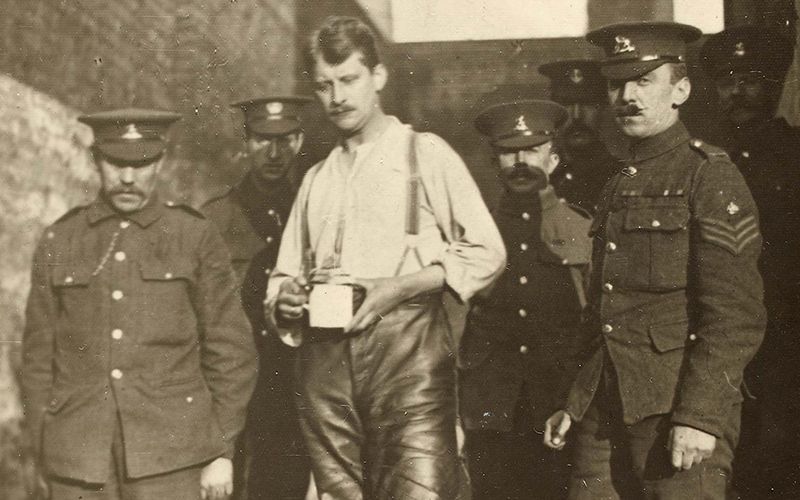More Lives Than One: The Remarkable Wilde Family Through the Generations
By Gerard Hanberry
Sometimes your fate arrives in the form of a lover. When Oscar Wilde wrote The Picture of Dorian Gray in 1890 his wife Constance noticed that many of their friends stopped speaking to them after it was published.
Then one day a young man turned up at the invitation of a friend, and Wilde discovered he had read the book nine times. Flattered by his attentions, Wilde fell hard for Lord Alfred Douglas, the blond haired son of the Marquis of Queensbury.
But all the Wildes lived their lives as though making themselves the ideal subjects for a biographer. Wilde’s father was a brilliant surgeon and his mother was the flamboyant Lady Jane, who wrote stirring nationalist poetry under the nom de plume Speranza.
The Wildes were a pair of mold breakers and provided an ideal springboard for the brilliant career of their singular son. But Oscar didn’t leap fully formed from his college days in Dublin. Both of his brilliant parents had taught him well, and Gerard Hanberry’s book seeks to restore their influence and importance to one of the wittiest and most incisive writers who ever lived.
In setting out to conquer the literary world, Wilde was himself harpooned by a petulant, changeable upper class toff who was in many ways his antithesis. There’s a strange unsettling kind of doom that hovers over his sad fate that will ensure his love story lasts for all time, an outcome he would probably have enjoyed had it not consumed him.
Dufour, $44.95
-----------------
Read more:
53-year old Irish carpenter re-emigrates to New York, describes why he had to leave
Top ten people I’d like to have a pint with
-----------------
Places We Play
Mike Cronin and Roisin Higgins
Anyone who grew up in Ireland will remember their local pitches and golf courses with fondness, be they ever so humble, and the majority of them were.
In their new book, Mike Cronin and Roisin Higgins explore national stadiums to the most derelict former homes of sporting glory and in the process they unravel generations of Irish sporting history.
These were the places were hopes and dreams came to life for an hour, and the book recalls the kind of women and men who dreamed them, tracing the impact and reach of sport in modern Ireland along the way.
So many groups had a hand – and in consequence a say – in how that history unfolded. Local tradesmen, politicians, landed wealth, the military, and the clergy all helped shape the idea of a national sporting heritage and this evocative and handsomely illustrated book brings that heritage to life.
Dufour, $44.95
The Savage City
By T.J. English
Now available in paperback, celebrated Irish American author T.J. English’s The Savage City is a bracing reminder of the racial powder keg that was New York City in the sixties and seventies.
Despite what we might like to think, racial struggles didn’t just happen in the south, since there were major battles happening right here in New York. The gloves came off between a police department that thrived on corruption and a suddenly militant black underclass, which began to agitate for their rights, with explosive results.
English reminds us that the struggle for civil rights was exactly that, when it was not an all out war on the city streets. In this immensely readable book, which propels the reader forward through a catalogue of horrors, English confirms his reputation as a master of gritty social history.
William Morrow, $15.95
Window and Mirror: RTE Television 1961-2011
By John Bowman
Few Irish commentators are better placed to record the changes to Ireland’s national broadcasting channel than the station’s own distinguished veteran broadcaster John Bowman.
In Window and Mirror: RTE Television 1961- 2011 he reminds us that 2011 marked the 50th anniversary of the station that reflected and sometimes led Irish opinion over five decades.
Bowman opens a window on Irish society over five decades, reminding us of the strong arming tactics employed by the clergy, politicians, and other competing strands of Irish society, including Gaelgeoirs.
What Bowman reminds us is how deeply the public sought to see the station as a forum to question prevailing attitudes and traditional values in a society that was discovering just how corrupt and cruel it had been under its apparently conservative surface.
The history of RTE turns out to be the history of an Irish people determined to shape its own future, Bowman argues. In his insightful and evocatively illustrated new book Bowman conjures decades of Irish social change in a compelling new book.
Dufour, $49.95
-----------------
Read more:
53-year old Irish carpenter re-emigrates to New York, describes why he had to leave
Top ten people I’d like to have a pint with
-----------------
By Gerard Hanberry
Sometimes your fate arrives in the form of a lover. When Oscar Wilde wrote The Picture of Dorian Gray in 1890 his wife Constance noticed that many of their friends stopped speaking to them after it was published.
Then one day a young man turned up at the invitation of a friend, and Wilde discovered he had read the book nine times. Flattered by his attentions, Wilde fell hard for Lord Alfred Douglas, the blond haired son of the Marquis of Queensbury.
But all the Wildes lived their lives as though making themselves the ideal subjects for a biographer. Wilde’s father was a brilliant surgeon and his mother was the flamboyant Lady Jane, who wrote stirring nationalist poetry under the nom de plume Speranza.
The Wildes were a pair of mold breakers and provided an ideal springboard for the brilliant career of their singular son. But Oscar didn’t leap fully formed from his college days in Dublin. Both of his brilliant parents had taught him well, and Gerard Hanberry’s book seeks to restore their influence and importance to one of the wittiest and most incisive writers who ever lived.
In setting out to conquer the literary world, Wilde was himself harpooned by a petulant, changeable upper class toff who was in many ways his antithesis. There’s a strange unsettling kind of doom that hovers over his sad fate that will ensure his love story lasts for all time, an outcome he would probably have enjoyed had it not consumed him.
Dufour, $44.95
-----------------
Read more:
53-year old Irish carpenter re-emigrates to New York, describes why he had to leave
Top ten people I’d like to have a pint with
-----------------
Places We Play
Mike Cronin and Roisin Higgins
Anyone who grew up in Ireland will remember their local pitches and golf courses with fondness, be they ever so humble, and the majority of them were.
In their new book, Mike Cronin and Roisin Higgins explore national stadiums to the most derelict former homes of sporting glory and in the process they unravel generations of Irish sporting history.
These were the places were hopes and dreams came to life for an hour, and the book recalls the kind of women and men who dreamed them, tracing the impact and reach of sport in modern Ireland along the way.
So many groups had a hand – and in consequence a say – in how that history unfolded. Local tradesmen, politicians, landed wealth, the military, and the clergy all helped shape the idea of a national sporting heritage and this evocative and handsomely illustrated book brings that heritage to life.
Dufour, $44.95
The Savage City
By T.J. English
Now available in paperback, celebrated Irish American author T.J. English’s The Savage City is a bracing reminder of the racial powder keg that was New York City in the sixties and seventies.
Despite what we might like to think, racial struggles didn’t just happen in the south, since there were major battles happening right here in New York. The gloves came off between a police department that thrived on corruption and a suddenly militant black underclass, which began to agitate for their rights, with explosive results.
English reminds us that the struggle for civil rights was exactly that, when it was not an all out war on the city streets. In this immensely readable book, which propels the reader forward through a catalogue of horrors, English confirms his reputation as a master of gritty social history.
William Morrow, $15.95
Window and Mirror: RTE Television 1961-2011
By John Bowman
Few Irish commentators are better placed to record the changes to Ireland’s national broadcasting channel than the station’s own distinguished veteran broadcaster John Bowman.
In Window and Mirror: RTE Television 1961- 2011 he reminds us that 2011 marked the 50th anniversary of the station that reflected and sometimes led Irish opinion over five decades.
Bowman opens a window on Irish society over five decades, reminding us of the strong arming tactics employed by the clergy, politicians, and other competing strands of Irish society, including Gaelgeoirs.
What Bowman reminds us is how deeply the public sought to see the station as a forum to question prevailing attitudes and traditional values in a society that was discovering just how corrupt and cruel it had been under its apparently conservative surface.
The history of RTE turns out to be the history of an Irish people determined to shape its own future, Bowman argues. In his insightful and evocatively illustrated new book Bowman conjures decades of Irish social change in a compelling new book.
Dufour, $49.95
-----------------
Read more:
53-year old Irish carpenter re-emigrates to New York, describes why he had to leave
Top ten people I’d like to have a pint with
-----------------




Comments